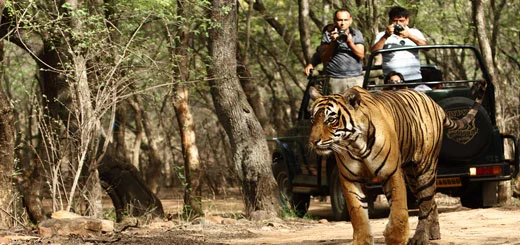
Definitely, many of us, when stuck in daily hectic lifestyles often prefer to get an escape from stress and for this nothing is better than going on a vacation that too in a wildlife destination. Yet there are myriads of wildlife places in India but from all those, Ranthambore has gained significant status in the field of offering the best jungle experience in the country. Keeping in mind the end goals of adding fun and excitement to monotonous lifestyles, planning a holiday in Ranthambore is the best-suggested option for you. Engulfed within the Aravali Range and plateau of Vindhyas, Ranthambore sets a perfect ambiance for getting a fun-filled getaway in the town of Sawai Madhopur, Rajasthan.
Why Ranthambore has become a Photographer’s haven?
In the era of wildlife extinction, Ranthambore has a significant role in untamed life that has pulled the attention of many nature lovers and wildlife photographers. Ranthambore National Park houses a large population of flora and fauna species, even the beautiful birds in the forest give a mind-blowing shot for a photographer. Most of the people think that encountering the rich flora and fauna species in Ranthambore Safari is absolutely costlier that strikes their budget for a photography tour to Ranthambore. On that note, going on a safari in Ranthambore could be conceivable on a shoestring budget.
Do you know Ranthambore National Park reveals the history as well?
Yes, of course, it is true because it was previously the royal hunting ground of Maharajas in Rajasthan which was also Rajasthan’s first Project Tiger Reserve. This place has got acclaimed because, during the years gone by, the royals of Jaipur used to chase there. In 1955, the government of India declared it as a national park and after that, it was turned into a Project Tiger, later it was proclaimed as a national park in 1980.
What made Ranthambore famous for tiger spotting?
Ranthambore National Park has gained popularity in the world all because of the female tigress Machli who once killed a 14-foot crocodile in a fight. The legendary tigress got her name because her face mark resembles a fish. Usually, the tiger’s lifespan is around 12-13 years but she was indeed India’s iconic tigress who died at the age of 20 years.
The national park is well known for tigers whose populace has been hazardously decreasing in recent decades. Additionally, the wild natural surroundings where many different fauna species like a hyena, sloth bear, wild pig, and many more reside is truly awful. Visiting Ranthambore means a bundle of opportunity to spot tigers in its natural habitat that’s quite different from what is commonly seen in fiction.
Which safari zone is best for tiger sighting?
Overall Ranthambore has 10 safari zones and all of them are great. Tigers are best sighted in zone 1 to zone 6 but zone 7 to 10 is also good. When it comes to choosing the safari zone for tiger sighting, it is necessary to know that you will be allotted with the zone on the spot by the safari organizers or forest management, so you won’t get a chance to select the zone of your interest.
Best time to visit Ranthambore
Ranthambore experiences hot and humid climate from March to July having a maximum temperature of about 460c, during the dusk, the temperature drops to at 300c. Monsoon in Ranthambore starts from July to September when the climate remains moist and gets thundershowers almost every week. Winter brings a favourable climate to explore the flora and fauna species which makes jungle safari convenient and suitable. Thus it is best to plan Ranthambore trip during the winter season.
So, gear up your wildlife safari essentials and get ready for enjoying a great vacation in Ranthambore while experiencing the wilderness of this place.